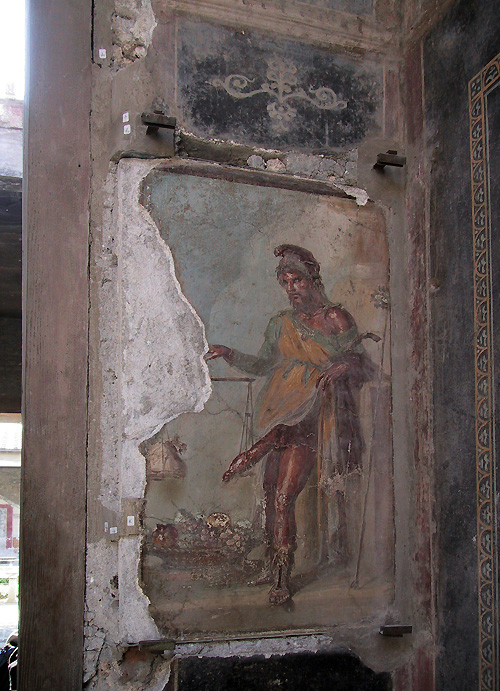
Priapus – a visual lesson for those who know the price of everything and the value of nothing
Casa dei Vettii provides us with a number of wall-paintings that juxtapose the mercurial world of trade, wealth generation and luxurious interiors. A set of ingredients that might cause us to associate the house with the pursuit of hedonism. However, a closer look at the paintings suggests that the owners, two brothers, had a more balanced view of the relationship between money and value then one might have first thought. One of the most striking images, and at the same time the most conceptually subtle, is a painting that confronts us at the entrance to the house. It is an image of the ithyphallic Priapus strategically placed at eye level immediately to the right of the front door. Anyone entering the house must, therefore, pass by his not so conceptually subtle enormous erect penis. Priapus performed many symbolic roles, one of the most significant being that of an apotropaic effigy. Like the so called ‘evil eye’ he was called upon to protect the house and its inhabitants from unbenign forces. On a more mundane and practical level he was also placed in fields and gardens as a scarecrow. However, the painting contains more than just the image of Priapus, which suggests that he was not only there in his fruits de la terre role. Somewhat shockingly, at least for the modern viewer, he appears to be using a pair of scales to weigh his phallus against a sack of money. Are we supposed to interpret from this action that it is worth its weight in gold and if so why? On the floor beneath the weighing scale is a basket overflowing with fresh fruit, positioned in such a way that the phallus appears to be pointing to it. Is this an indication of where the real wealth lies? Are we being made aware that the owners of this house understand the true value of the relationship between fertility, nature's produce and income generation? The composition places nature's produce at the base of the tripartite relationship, over which looms the personification of nature's mysterious life-force. The money bag on the other hand, although an important part of the equation, is given a less significant visual presence. In this context we can view the painting as a form of pagan eucharist, in which Priapus who was responsible for nature’s bounty was, therefore, the first to be offered its new fruits. After all the forces of nature were known to destroy as well as provide.
Hence, the painting was designed to confront, in the apotropaic sense, and at the same time function as a thanksgiving symbol, poetically reminding the viewer of nature's fecundity. The fact that Priapus was also the son of a powerful chthonic deity and the equally powerful love goddess Venus-Aphrodite would not have gone unnoticed, especially since both are emblematically reinforced by the painting's overt sexual reference and the thyrsos of Bacchus-Dionysus propped up against the wall next to Priapus. His image, in sculptural form, also appears in the garden, complete with an erect penis that provides the water source for a fountain. Its l’eau de vie symbolism, signified by his presence, provides a perfect counterpoint to the fruits de la terre symbolism in the wall-painting.
|